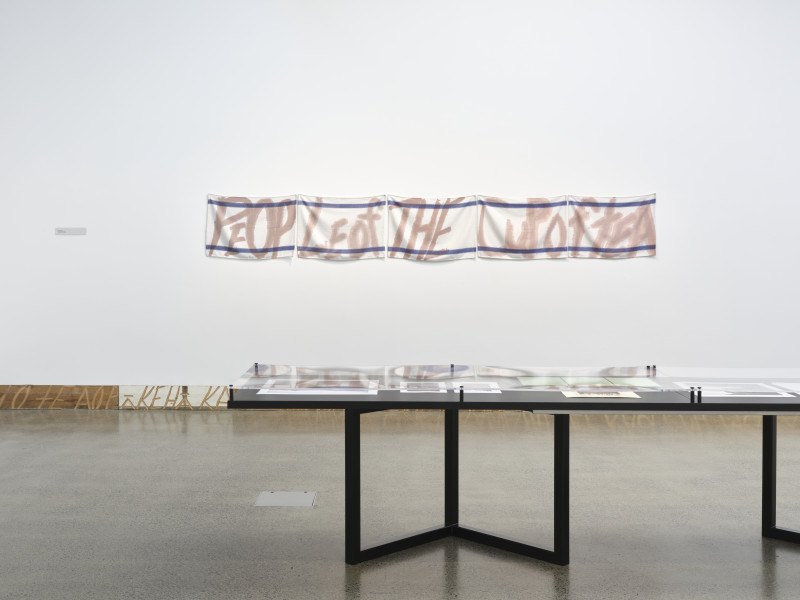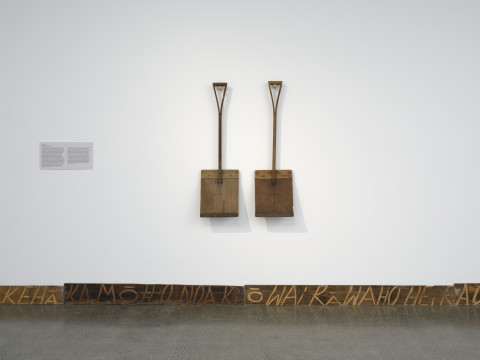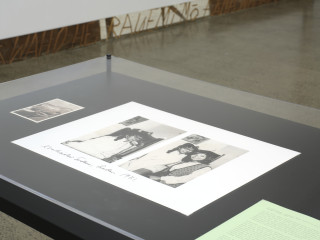Te Uru Waitakere Contemporary Gallery's exhibition of works by Newell Harry and Peter Simpson.
Exhibition Dates: 31 August – 10 November 2024
from elsewhere is the first in a new series of dialogue exhibitions at Te Uru that connect local and international artists. This exhibition brings together the practices of Australian-born, South African/Mauritian artist Newell Harry (b.1972) and Aotearoa-born artist Peter Simpson (b.1990, Ngāti Maniapoto, Waikato-Tainui, Ngāti Pāoa, Ngāti Tamaterā, Indian, Pākehā). Both artists contend with dominant histories in their work through research-led practices and the repurposing of found material.
The exhibition title is drawn from a quote in philosopher Frantz Fanon’s 1961 book The Wretched of the Earth: ‘The governing race is first and foremost those who come from elsewhere, those who are unlike the original inhabitants, “the others.”’ In this astute observation, ‘otherness’ refers subversively to settler colonialism. Fundamentally, this quote addresses the movement of peoples and ideas around the world, emphasising the very notion of being ‘from elsewhere’ and the often irreconcilable differences that arise as a result. For Harry and Simpson, observing movements between contexts is a way to map the history and politics of cross-cultural junction.
For Harry, this often involves travel throughout the Moana Oceania region, where he forms connections with local communities and histories through conversation, trade, and his own forms of documentary photography and writing. His growing collection of objects and ephemera from these sojourns have previously been used for sculptures and installations, but are increasingly presented unaltered in vitrines, like archival material. These constellations of material critically cite accepted, often archaic norms through the simple re-presentation of historical documents and collected objects. Harry’s considered arrangements for these displays chart unexpected historical threads and connections, illuminating counter-narratives that embrace anecdotal, suppressed, and incidental circumstances. In from elsewhere, Harry has assembled a new suite of mementos that index several networks of people and places relevant to the construction of his own history.
Simpson’s research focuses more locally on Māori experience and histories, especially concerning the prevailing consequences of Pākehā ideologies. He develops philosophical texts in Te Reo and English, which are painted onto or carved into surfaces of repurposed materials that reference labour, domesticity, and customs. He also investigates writing as a colonial project, and has previously adapted pages from canonical works of travel literature by painting over them with motifs such as kowhaiwhai. This intersecting of Māori and Pākehā heritage is a constant in Simpson’s work. Western ideas, art tropes, and iconography such as ships are frequently problematised by Mātauranga Māori, which renders European tenets absurd. The subtle humour and irreverence that emerges is echoed by Simpson’s use of quick mark-making and vernacular.
The use and politics of language is significant to the practices of both artists, often employed as text in a range of tongues by Harry and Simpson to identify slippages and plural meanings, and to unsettle colonial frameworks of knowledge and understanding.
The portability of both language and the object-forms comprising their works (for instance slides, photographs, or documents) carries significant implications—of trade across times and places and subsequent developments or losses of meaning. In considering such interactions through the practices of Harry and Simpson, from elsewhere fundamentally questions the effects that transporting culture has on society, politics, and history.
Curated by James Gatt.

















